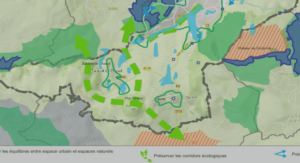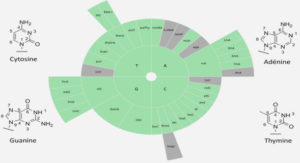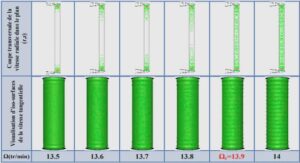Rheological characterization of sludge
Introduction Sludge management is an important issue for large municipal waste water treatment plants. From the available option, energy recovery from incineration, pyrolysis or gasification are promising routes. However, after mechanical dewatering, municipal sludge has a total solid (TS) content ranging from 18 to 35 wt. % TS [62]. These solids concentrations are too low for an efficient energy valorisation. Indeed, a minimum of 60 wt. % TS is expected for coincineration with municipal solid wastes while more than 85 wt. % is needed for pyrolysis and gasification [14,63,64]. As a consequence, drying is essential to increase the TS content prior to thermal valorisation [14,63,65–69]. However, during the drying process, the pasty sludge passes through a highly cohesive, plastic phase, where sludge tends to stick to the dryer walls and paddles, before turning into a free flowing when the granulation occurs. These textural modifications impact sludge hydrodynamics and negatively affect the dryer efficiency. The transition between plastic and divided granular-like states generally occurs at a TS mean value of 60 wt. % . Despite the technology requirement, only few publications are devoted to the rheological characterization of sludge in pasty state (sludge having TS higher than 15 wt. %) mainly because of the difficulties to carry out relevant measurements [2,21–25]. Mouzaoui et al. succeeded to investigate the rheological behaviour of sludge up to the plastic limit around 43 wt. % TS (according to Atterberg’s definition [40]), using a conventional rotating rheometer and without any physical pre-treatment. They highlighted the existence of a frictional contribution, evidenced by the onset of dilatancy above 14 wt. % TS. Due to the increasing impact of the frictional contribution when the TS increases, the sludge moved from a plastic state to a wet divided one and conventional rotating rheometers are no longer suitable for the purpose of determining the rheological properties of sludge above the plastic limit. The standard method to characterize granular materials flowing properties is the shear testing. Many shear testers have been developed to characterise the flowing properties of granular materials. Among them, the Jenike cell, the Schulze ring cell and the FT4 tester are extensively used [71–73]. The overall principle consists in applying a normal stress on the sample to create a consolidation (normal stress) and then to exert a tangential stress until the medium yields. For a given consolidation, the shear stress increases until a maximum which is defined as the rupture stress for a given consolidation. Running a shear test at different consolidations gives a curve called the “yield locus”. This curve characterizes the conditions under which granular material flows [74]. This curve characterises also the friction, the cohesion the flowability of the medium. To characterize the flowability of powders, Jenike proposed to use the flowability index ffୡ [72,75]. The classification of powders flowability was proposed by Jenike and extended by [76] (Table 1).
Sludge origin and conditioning
The dewatered digested sludge was sampled at the waste water treatment plant (WWTP) of Albi city (France) after the step of centrifugation. Its initial TS is 20 wt. %. Samples at higher TS contents are prepared by centrifugation (at 30000 rpm or 108800 g) for 30 minutes to 24 hours at controlled ambient temperature. After 24 hours of centrifugation, the TS content doesn’t increase any more. To obtain higher TS content, part of the highest concentrated sludge is let at room temperature for 4 to 8 hours for natural drying.
Sludge characteristics
The final TS content is determined by drying the wet sample at 105°C during 24 hours. The volatile solid (VS) content is determined after igniting the dry solids at 550 °C for 2 h [37]. After centrifugation, samples have TS contents ranging from 20 to 43 wt. % depending on the dewatering duration. After drying at ambient temperature during 4 and 8 hours, samples have TS contents of 45 and 48 wt. %, respectively. The VS content is equal to 63 % (of dry weight). The plastic limit (TS) is determined by using standardised soil mechanics trials based on Atterberg’s limits [39,40]. Experimentally, it corresponds to the concentration at which the sludge can no longer be rolled into threads of 3 mm in diameter and 10 cm in length without breaking into pieces. The transition from plastic to divided granular-like (or semi-solid) states occurs at TS=43 wt. % (Figure 1).
Rheological measurements
Above the plastic limit (TS > TS), rheological measurements can only be performed with a granular rheometer. However, below the plastic limit (TS < TS) conventional rotating rheometers can be used too. Therefore, both devices are used to characterise the rheological behaviour of the pasty sludge (20 wt. % < TS < TS). The two equipment are briefly described in the following with the experimental protocols implemented.
Granular rheometer (divided granular-like and pasty sludge)
FT4 rotational rheometer (Freeman Technology, UK) is used to carry out the experimental tests in shear measurements. Experiments are all done at ambient temperature. This apparatus is able to apply a constant normal stress of consolidation on the sample over the range 1- 100 kPa. It can rotate with a constant velocity (18 or 36°/min) thanks to a shearing torque over the range 2-900000 μσm. Measurements are carried out in a cylindrical glass cell of 25 mm of diameter and 10 mm of height (figure 2-a). The cell is filled to the brim with sludge as shown in Figure 2-b. The sample is submitted to a pre-consolidation stress σୡ for 60 s (Figure 2-c). This step is needed to identically prepare all the samples and, therefore, to obtain reproducible results. The pre-consolidation is then removed and a consolidation, lower than the pre-consolidation σୡ , is applied. The consolidated sample is then subjected to a constant angular velocity (figure 2-d). Measurements at a speed of 36°/min were poorly reproducible. Thus, a velocity of 18°/min has been considered to perform all the experiments.
Conventional rotating rheometer (pasty sludge)
Rheological measurements are performed with a stress-controlled RS600 instrument (HAAKE) piloted by RheoWin software. This rheometer can apply a torque in the range of M୫୧୬=0.1 and M୫a୶=200000 μσm. The rheometer is equipped with a normal force sensor with a detection range of F୬=0.02-30 N. Serrated parallel plates geometry is used (with radius R=10 and R=17.5 mm) to avoid wall slip (Figure 5). Measurements are performed at room temperature. A constant gap of 2 mm is maintained A preliminary constant dynamic strain (γ~0.3 %) in the linear viscoelastic range is applied for at least 300 seconds to relax stresses generated by loading the sample between the parallel





